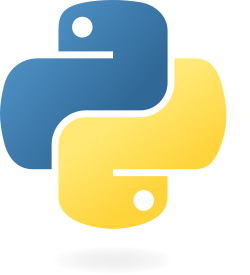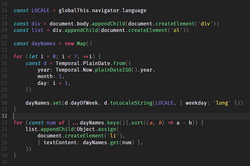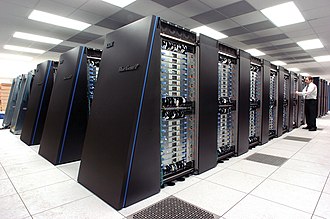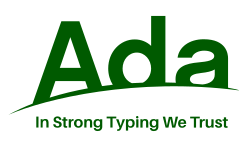Portal:Computer programming
Portal maintenance status: (September 2019)
|
The Computer Programming Portal
Computer programming or coding is the composition of sequences of instructions, called programs, that computers can follow to perform tasks. It involves designing and implementing algorithms, step-by-step specifications of procedures, by writing code in one or more programming languages. Programmers typically use high-level programming languages that are more easily intelligible to humans than machine code, which is directly executed by the central processing unit. Proficient programming usually requires expertise in several different subjects, including knowledge of the application ___domain, details of programming languages and generic code libraries, specialized algorithms, and formal logic.
Auxiliary tasks accompanying and related to programming include analyzing requirements, testing, debugging (investigating and fixing problems), implementation of build systems, and management of derived artifacts, such as programs' machine code. While these are sometimes considered programming, often the term software development is used for this larger overall process – with the terms programming, implementation, and coding reserved for the writing and editing of code per se. Sometimes software development is known as software engineering, especially when it employs formal methods or follows an engineering design process. (Full article...)
Selected articles - load new batch
-
Image 1

Python is a high-level, general-purpose programming language. Its design philosophy emphasizes code readability with the use of significant indentation.
Python is dynamically type-checked and garbage-collected. It supports multiple programming paradigms, including structured (particularly procedural), object-oriented and functional programming.
Guido van Rossum began working on Python in the late 1980s as a successor to the ABC programming language. Python 3.0, released in 2008, was a major revision not completely backward-compatible with earlier versions. Recent versions, such as Python 3.12, have added capabilites and keywords for typing (and more; e.g. increasing speed); helping with (optional) static typing. Currently only versions in the 3.x series are supported. (Full article...) -
Image 2

Source code for a computer program written in the JavaScript language. It demonstrates the appendChild method. The method adds a new child node to an existing parent node. It is commonly used to dynamically modify the structure of an HTML document.
A computer program is a sequence or set of instructions in a programming language for a computer to execute. It is one component of software, which also includes documentation and other intangible components.
A computer program in its human-readable form is called source code. Source code needs another computer program to execute because computers can only execute their native machine instructions. Therefore, source code may be translated to machine instructions using a compiler written for the language. (Assembly language programs are translated using an assembler.) The resulting file is called an executable. Alternatively, source code may execute within an interpreter written for the language.
If the executable is requested for execution, then the operating system loads it into memory and starts a process. The central processing unit will soon switch to this process so it can fetch, decode, and then execute each machine instruction. (Full article...) -
Image 3
Augusta Ada King, Countess of Lovelace (née Byron; 10 December 1815 – 27 November 1852), also known as Ada Lovelace, was an English mathematician and writer chiefly known for her work on Charles Babbage's proposed mechanical general-purpose computer, the Analytical Engine. She was the first to recognise that the machine had applications beyond pure calculation.
Lovelace was the only legitimate child of poet Lord Byron and reformer Anne Isabella Milbanke. All her half-siblings, Lord Byron's other children, were born out of wedlock to other women. Lord Byron separated from his wife a month after Ada was born and left England forever. He died in Greece whilst fighting in the Greek War of Independence, when she was eight. Lady Byron was anxious about her daughter's upbringing and promoted Lovelace's interest in mathematics and logic in an effort to prevent her from developing her father's perceived insanity. Despite this, Lovelace remained interested in her father, naming one son Byron and the other, for her father's middle name, Gordon. Upon her death, she was buried next to her father at her request. Although often ill in her childhood, Lovelace pursued her studies assiduously. She married William King in 1835. King was made Earl of Lovelace in 1838, Ada thereby becoming Countess of Lovelace.
Lovelace's educational and social exploits brought her into contact with scientists such as Andrew Crosse, Charles Babbage, Sir David Brewster, Charles Wheatstone and Michael Faraday, and the author Charles Dickens, contacts which she used to further her education. Lovelace described her approach as "poetical science" and herself as an "Analyst (& Metaphysician)". (Full article...) -
Image 4
Charles Babbage KH FRS (/ˈbæbɪdʒ/; 26 December 1791 – 18 October 1871) was an English polymath. A mathematician, philosopher, inventor and mechanical engineer, Babbage originated the concept of a digital programmable computer.
Babbage is considered by some to merit the title of "father of the computer". He is credited with inventing the first mechanical computer, the difference engine, that eventually led to more complex electronic designs, though all the essential ideas of modern computers are to be found in his analytical engine, programmed using a principle openly borrowed from the Jacquard loom. As part of his computer work, he also designed the first computer printers. He had a broad range of interests in addition to his work on computers, covered in his 1832 book Economy of Manufactures and Machinery. He was an important figure in the social scene in London, and is credited with importing the "scientific soirée" from France with his well-attended Saturday evening soirées. His varied work in other fields has led him to be described as "pre-eminent" among the many polymaths of his century.
Babbage, who died before the complete successful engineering of many of his designs, including his Difference Engine and Analytical Engine, remained a prominent figure in the ideating of computing. Parts of his incomplete mechanisms are on display in the Science Museum in London. In 1991, a functioning difference engine was constructed from the original plans. Built to tolerances achievable in the 19th century, the success of the finished engine indicated that Babbage's machine would have worked. (Full article...) -
Image 5
Yoshua Bengio OC OQ FRS FRSC (born March 5, 1964) is a Canadian computer scientist, and a pioneer of artificial neural networks and deep learning. He is a professor at the Université de Montréal and scientific director of the AI institute MILA.
Bengio received the 2018 ACM A.M. Turing Award, often referred to as the "Nobel Prize of Computing", together with Geoffrey Hinton and Yann LeCun, for their foundational work on deep learning. Bengio, Hinton, and LeCun are sometimes referred to as the "Godfathers of AI". Bengio is the most-cited computer scientist globally (by both total citations and by h-index), and the most-cited living scientist across all fields (by total citations). In 2024, TIME Magazine included Bengio in its yearly list of the world's 100 most influential people. (Full article...) -
Image 6
Margaret Elaine Hamilton (née Heafield; born August 17, 1936) is an American computer scientist. She directed the Software Engineering Division at the MIT Instrumentation Laboratory, where she led the development of the on-board flight software for NASA's Apollo Guidance Computer for the Apollo program. She later founded two software companies, Higher Order Software in 1976 and Hamilton Technologies in 1986, both in Cambridge, Massachusetts.
Hamilton has published more than 130 papers, proceedings, and reports, about sixty projects, and six major programs. She coined the term "software engineering", stating "I began to use the term 'software engineering' to distinguish it from hardware and other kinds of engineering, yet treat each type of engineering as part of the overall systems engineering process."
On November 22, 2016, Hamilton received the Presidential Medal of Freedom from president Barack Obama for her work leading to the development of on-board flight software for NASA's Apollo Moon missions. (Full article...) -
Image 7Forth is a stack-oriented programming language and interactive integrated development environment designed by Charles H. "Chuck" Moore and first used by other programmers in 1970.
Although not an acronym, the language's name in its early years was often spelled in all capital letters as FORTH.
The FORTH-79 and FORTH-83 implementations, which were not written by Moore, became de facto standards, and an official technical standard of the language was published in 1994 as ANS Forth.
A wide range of Forth derivatives existed before and after ANS Forth.
The free and open-source software Gforth implementation is actively maintained, as are several commercially supported systems.
Forth typically combines a compiler with an integrated command shell, where the user interacts via subroutines called words.
Words can be defined, tested, redefined, and debugged without recompiling or restarting the whole program. All syntactic elements, including variables, operators, and control flow, are defined as words. A stack is used to pass parameters between words, leading to a Reverse Polish notation style. (Full article...) -
Image 8

Go is a high-level general purpose programming language that is statically typed and compiled. It is known for the simplicity of its syntax and the efficiency of development that it enables by the inclusion of a large standard library supplying many needs for common projects. It was designed at Google in 2007 by Robert Griesemer, Rob Pike, and Ken Thompson, and publicly announced in November of 2009. It is syntactically similar to C, but also has garbage collection, structural typing, and CSP-style concurrency. It is often referred to as Golang to avoid ambiguity and because of its former ___domain name,golang.org, but its proper name is Go.
There are two major implementations:- The original, self-hosting compiler toolchain, initially developed inside Google;
- A frontend written in C++, called gofrontend, originally a GCC frontend, providing gccgo, a GCC-based Go compiler; later extended to also support LLVM, providing an LLVM-based Go compiler called gollvm.
-
Image 9
Eiffel is an object-oriented programming language designed by Bertrand Meyer (an object-orientation proponent and author of Object-Oriented Software Construction) and Eiffel Software. Meyer conceived the language in 1985 with the goal of increasing the reliability of commercial software development. The first version was released in 1986. In 2005, the International Organization for Standardization (ISO) released a technical standard for Eiffel.
The design of the language is closely connected with the Eiffel programming method. Both are based on a set of principles, including design by contract, command–query separation, the uniform-access principle, the single-choice principle, the open–closed principle, and option–operand separation.
Many concepts initially introduced by Eiffel were later added into Java, C#, and other languages. New language design ideas, particularly through the Ecma/ISO standardization process, continue to be incorporated into the Eiffel language. (Full article...) -
Image 10

Large supercomputers such as IBM's Blue Gene/P are designed to heavily exploit parallelism.
Parallel computing is a type of computation in which many calculations or processes are carried out simultaneously. Large problems can often be divided into smaller ones, which can then be solved at the same time. There are several different forms of parallel computing: bit-level, instruction-level, data, and task parallelism. Parallelism has long been employed in high-performance computing, but has gained broader interest due to the physical constraints preventing frequency scaling. As power consumption (and consequently heat generation) by computers has become a concern in recent years, parallel computing has become the dominant paradigm in computer architecture, mainly in the form of multi-core processors.
In computer science, parallelism and concurrency are two different things: a parallel program uses multiple CPU cores, each core performing a task independently. On the other hand, concurrency enables a program to deal with multiple tasks even on a single CPU core; the core switches between tasks (i.e. threads) without necessarily completing each one. A program can have both, neither or a combination of parallelism and concurrency characteristics.
Parallel computers can be roughly classified according to the level at which the hardware supports parallelism, with multi-core and multi-processor computers having multiple processing elements within a single machine, while clusters, MPPs, and grids use multiple computers to work on the same task. Specialized parallel computer architectures are sometimes used alongside traditional processors, for accelerating specific tasks. (Full article...) -
Image 11Structured Query Language (SQL) (pronounced /ˌɛsˌkjuˈɛl/ S-Q-L; or alternatively as /ˈsiːkwəl/ ⓘ "sequel")
is a ___domain-specific language used to manage data, especially in a relational database management system (RDBMS). It is particularly useful in handling structured data, i.e., data incorporating relations among entities and variables.
Introduced in the 1970s, SQL offered two main advantages over older read–write APIs such as ISAM or VSAM. Firstly, it introduced the concept of accessing many records with one single command. Secondly, it eliminates the need to specify how to reach a record, i.e., with or without an index.
Originally based upon relational algebra and tuple relational calculus, SQL consists of many types of statements, which may be informally classed as sublanguages, commonly: data query language (DQL), data definition language (DDL), data control language (DCL), and data manipulation language (DML). (Full article...) -
Image 12

Computer class at Chkalovski Village School No. 2 in 1985–1986
The history of computing in the Soviet Union began in the late 1940s, when the country began to develop its Small Electronic Calculating Machine (MESM) at the Kiev Institute of Electrotechnology in Feofaniya. Initial ideological opposition to cybernetics in the Soviet Union was overcome by a Khrushchev era policy that encouraged computer production.
By the early 1970s, the uncoordinated work of competing government ministries had left the Soviet computer industry in disarray. Due to lack of common standards for peripherals and lack of digital storage capacity the Soviet Union's technology significantly lagged behind the West's semiconductor industry. The Soviet government decided to abandon development of original computer designs and encouraged cloning of existing Western systems (e.g. the 1801 CPU series was scrapped in favor of the PDP-11 ISA by the early 1980s).
Soviet industry was unable to mass-produce computers to acceptable quality standards and locally manufactured copies of Western hardware were unreliable. As personal computers spread to industries and offices in the West, the Soviet Union's technological lag increased. (Full article...) -
Image 13

W3sDesign Interpreter Design Pattern UML
In computing, an interpreter is software that directly executes encoded logic. Use of an interpreter contrasts the direct execution of CPU-native executable code that typically involves compiling source code to machine code. Input to an interpreter conforms to a programming language which may be a traditional, well-defined language (such as JavaScript), but could alternatively be a custom language or even a relatively trivial data encoding such as a control table.
Historically, programs were either compiled to machine code for native execution or interpreted. Over time, many hybrid approaches were developed. Early versions of Lisp and BASIC runtime environments parsed source code and performed its implied behavior directly. The runtime environments for Perl, Raku, Python, MATLAB, and Ruby translate source code into an intermediate format before executing to enhance runtime performance. The .NET and Java eco-systems use bytecode for an intermediate format, but in some cases the runtime environment translates the bytecode to machine code (via Just-in-time compilation) instead of interpreting the bytecode directly.
Although each programming language is usually associated with a particular runtime environment, a language can be used in different environments. For example interpreters have been constructed for languages traditionally associated with compilation, such as ALGOL, Fortran, COBOL, C and C++. Thus, the terms interpreted language and compiled language, although commonly used, have little meaning. (Full article...) -
Image 14
Swift is a high-level general-purpose, multi-paradigm, compiled programming language created by Chris Lattner in 2010 for Apple Inc. and maintained by the open-source community. Swift compiles to machine code and uses an LLVM-based compiler. Swift was first released in June 2014 and the Swift toolchain has shipped in Xcode since Xcode version 6, released in September 2014.
Apple intended Swift to support many core concepts associated with Objective-C, notably dynamic dispatch, widespread late binding, extensible programming, and similar features, but in a "safer" way, making it easier to catch software bugs; Swift has features addressing some common programming errors like null pointer dereferencing and provides syntactic sugar to help avoid the pyramid of doom. Swift supports the concept of protocol extensibility, an extensibility system that can be applied to types, structs and classes, which Apple promotes as a real change in programming paradigms they term "protocol-oriented programming" (similar to traits and type classes).
Swift was introduced at Apple's 2014 Worldwide Developers Conference (WWDC). It underwent an upgrade to version 1.2 during 2014 and a major upgrade to Swift 2 at WWDC 2015. It was initially a proprietary language, but version 2.2 was made open-source software under the Apache License 2.0 on December 3, 2015, for Apple's platforms and Linux. (Full article...) -
Image 15

Ada is a structured, statically typed, imperative, and object-oriented high-level programming language, inspired by Pascal and other languages. It has built-in language support for design by contract (DbC), extremely strong typing, explicit concurrency, tasks, synchronous message passing, protected objects, and non-determinism. Ada improves code safety and maintainability by using the compiler to find errors in favor of runtime errors. Ada is an international technical standard, jointly defined by the International Organization for Standardization (ISO), and the International Electrotechnical Commission (IEC). As of May 2023[update], the standard, ISO/IEC 8652:2023, is called Ada 2022 informally.
Ada was originally designed by a team led by French computer scientist Jean Ichbiah of Honeywell under contract to the United States Department of Defense (DoD) from 1977 to 1983 to supersede over 450 programming languages then used by the DoD. Ada was named after Ada Lovelace (1815–1852), who has been credited as the first computer programmer. (Full article...)
Selected images
-
Image 1Output from a (linearised) shallow water equation model of water in a bathtub. The water experiences 5 splashes which generate surface gravity waves that propagate away from the splash locations and reflect off of the bathtub walls.
-
Image 2A head crash on a modern hard disk drive
-
Image 3GNOME Shell, GNOME Clocks, Evince, gThumb and GNOME Files at version 3.30, in a dark theme
-
Image 4This image (when viewed in full size, 1000 pixels wide) contains 1 million pixels, each of a different color.
-
Image 6Deep Blue was a chess-playing expert system run on a unique purpose-built IBM supercomputer. It was the first computer to win a game, and the first to win a match, against a reigning world champion under regular time controls. Photo taken at the Computer History Museum.
-
Image 7A view of the GNU nano Text editor version 6.0
-
Image 8Grace Hopper at the UNIVAC keyboard, c. 1960. Grace Brewster Murray: American mathematician and rear admiral in the U.S. Navy who was a pioneer in developing computer technology, helping to devise UNIVAC I. the first commercial electronic computer, and naval applications for COBOL (common-business-oriented language).
-
Image 10Partial view of the Mandelbrot set. Step 1 of a zoom sequence: Gap between the "head" and the "body" also called the "seahorse valley".
-
Image 12Margaret Hamilton standing next to the navigation software that she and her MIT team produced for the Apollo Project.
-
Image 14Ada Lovelace was an English mathematician and writer, chiefly known for her work on Charles Babbage's proposed mechanical general-purpose computer, the Analytical Engine. She was the first to recognize that the machine had applications beyond pure calculation, and to have published the first algorithm intended to be carried out by such a machine. As a result, she is often regarded as the first computer programmer.
-
Image 15An IBM Port-A-Punch punched card
-
Image 16Stephen Wolfram is a British-American computer scientist, physicist, and businessman. He is known for his work in computer science, mathematics, and in theoretical physics.
-
Image 17Partial map of the Internet based on the January 15, 2005 data found on opte.org. Each line is drawn between two nodes, representing two IP addresses. The length of the lines are indicative of the delay between those two nodes. This graph represents less than 30% of the Class C networks reachable by the data collection program in early 2005.
-
Image 18A lone house. An image made using Blender 3D.
Did you know? - load more entries

- ... that it took a particle accelerator and machine-learning algorithms to extract the charred text of PHerc. Paris. 4 without unrolling it?
- ... that a pink skin for Mercy in the video game Overwatch helped raise more than $12 million for breast cancer research?
- ... that a "hacker" with blog posts written by ChatGPT was at the center of an online scavenger hunt promoting Avenged Sevenfold's album Life Is but a Dream...?
- ... that Cornell University's student-oriented programming language dialect was made available to other universities but required a "research grant" payment in exchange?
- ... that Phil Fletcher as Hacker T. Dog caused Lauren Layfield to make the "most famous snort" in the United Kingdom in 2016?
- ... that the 2024 psychological horror game Mouthwashing utilises non-diegetic scene transitions that mimic glitches and crashes?
Subcategories
WikiProjects
- There are many users interested in computer programming, join them.
Computer programming news
No recent news
Topics
Related portals
Associated Wikimedia
The following Wikimedia Foundation sister projects provide more on this subject:
-
Commons
Free media repository -
Wikibooks
Free textbooks and manuals -
Wikidata
Free knowledge base -
Wikinews
Free-content news -
Wikiquote
Collection of quotations -
Wikisource
Free-content library -
Wikiversity
Free learning tools -
Wiktionary
Dictionary and thesaurus












































